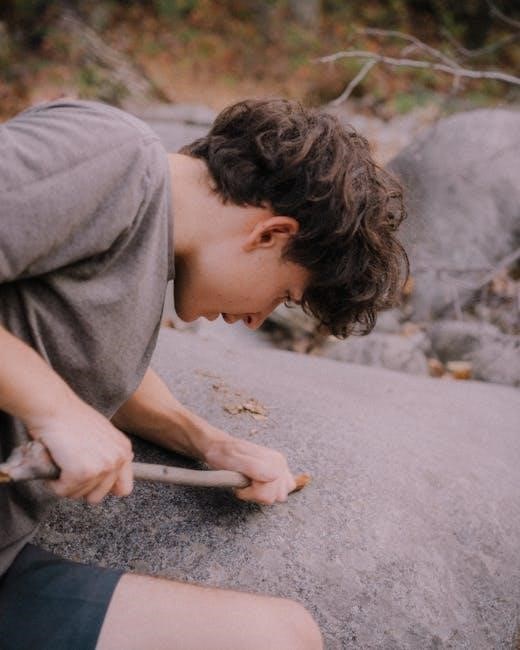Manual Rock Crusher: A Comprehensive Guide
A manual rock crusher is a cost-effective and durable tool for gold prospecting and small-scale mining. It efficiently crushes rock into smaller fragments, making it ideal for extracting valuable minerals and ores.
A manual rock crusher is a practical tool for small-scale mining and gold prospecting. Designed to be portable and efficient, these crushers allow users to process rocks and ores manually, making them ideal for remote or DIY operations. They are typically compact, lightweight, and cost-effective compared to electric or hydraulic crushers. Many enthusiasts and prospectors choose to build their own manual rock crushers using readily available materials, such as iron pipes and steel plates, ensuring durability and functionality. These devices are often simple in design, relying on basic mechanical principles to crush rock into smaller fragments. With proper construction and maintenance, a manual rock crusher can be a valuable asset for extracting valuable minerals and ores. Their popularity stems from their accessibility and effectiveness in breaking down tough rock, making them a staple in many gold prospecting kits. Whether store-bought or homemade, manual rock crushers offer a reliable way to process materials in the field.
History and Background of Manual Rock Crushers

Manual rock crushers have a long history, dating back to the early days of mining and prospecting. These devices were initially developed to assist in breaking down ore and rock samples for further processing. Over time, they evolved into more refined tools, with designs influenced by the needs of small-scale miners and DIY enthusiasts. The concept of manually operated crushers gained popularity during the gold rushes of the 19th century, where prospectors needed portable and affordable methods to process gold-bearing rocks. Early models were often crude, relying on simple mechanical principles like leverage and grinding. As materials science advanced, so did the design of manual rock crushers, with improvements in durability and efficiency. Today, these tools remain popular among hobbyists and small-scale miners, offering a cost-effective and reliable way to crush rocks for mineral extraction. Their enduring appeal lies in their simplicity and effectiveness, making them a timeless asset in the field of prospecting.
Materials and Tools Needed to Build a Manual Rock Crusher
Building a manual rock crusher requires a combination of durable materials and essential tools. The primary components include high-strength iron or steel pipes, which serve as the frame and crushing chamber. Additional materials such as thick iron boards, robust hinges, and a sturdy handle are necessary for structural integrity. An angle grinder or saw is needed to cut and shape the metal components. An arc welding kit is essential for assembling the crusher’s frame and ensuring strong, lasting joints. Other tools include a drill for creating holes, C-clamps for holding parts in place, and safety gear like gloves and goggles. A 1 HP motor may also be required for automated operation, depending on the design. Optional materials, such as manganese steel for the crushing plates, can enhance durability. Proper selection and preparation of these materials and tools are critical to ensure the crusher functions effectively and withstands heavy use.

Step-by-Step Guide to Building a Manual Rock Crusher
Constructing a manual rock crusher begins with gathering all necessary materials and tools. Start by cutting the iron pipes into equal lengths using an angle grinder, forming the frame. Next, weld the pipes together to create a sturdy base. Attach the iron board to one end, serving as the crushing plate, and secure the handle to the opposite side for operation. Ensure all joints are tightly welded for durability. Once the frame is complete, assemble the crushing mechanism by attaching the moving jaw and hinge system. Test the crusher by feeding small rocks into the chamber and turning the handle to ensure smooth operation. Fine-tune any loose parts and apply lubrication where needed. Finally, perform a safety check to confirm that all components are securely fastened. This step-by-step process ensures a functional and reliable manual rock crusher for gold prospecting or small-scale mining activities.
Safety Considerations When Using a Manual Rock Crusher
Operating a manual rock crusher requires careful attention to safety to avoid accidents and injuries. Always wear protective gear, including gloves, safety goggles, and a dust mask, to shield yourself from flying debris and dust. Ensure the crusher is placed on a stable, even surface to prevent tipping. Keep loose clothing and long hair tied back to avoid entanglement with moving parts. Never operate the crusher near children or pets, and ensure bystanders maintain a safe distance. Before use, inspect the tool for any damage or wear, especially around the hinges and handles. Avoid crushing rocks that contain harmful substances like quartz, which can release hazardous silica dust. Use the correct technique when turning the handle to maintain control and avoid overexertion. Finally, keep the crusher well-lubricated to reduce friction and wear on moving parts. By adhering to these safety guidelines, you can minimize risks and enjoy safe, effective operation of your manual rock crusher.
Operating and Maintaining a Manual Rock Crusher
Operating a manual rock crusher requires a systematic approach to ensure efficiency and longevity. Begin by feeding rocks into the crusher’s inlet, ensuring they are appropriately sized for the machine. Avoid overloading, as this can strain the mechanism. For smaller rocks, place them directly into the crushing chamber, while larger rocks may need to be broken down first. Always maintain a steady, controlled pace when turning the handle to avoid applying excessive pressure, which could damage the gears or hinges.
Regular maintenance is crucial. Lubricate the moving parts, such as the hinges and pivot points, to reduce friction and wear. After each use, clean the crusher to remove dust and debris, which can interfere with its performance. Store the crusher in a dry, secure location to protect it from environmental damage. Inspect the tool periodically for signs of wear, such as cracks or worn-out components, and replace them promptly to ensure optimal functionality. By following these operating and maintenance guidelines, you can extend the lifespan of your manual rock crusher and achieve consistent results in your mineral extraction efforts.
Effectiveness of Manual Rock Crushers for Gold Prospecting
Manual rock crushers are highly effective tools for gold prospecting, offering an affordable and efficient way to process ore and extract valuable minerals. Their compact design allows prospectors to crush small to medium-sized rocks into fine fragments, releasing gold particles that might otherwise remain trapped. The simplicity of these crushers makes them ideal for remote or hard-to-reach locations, where access to electricity or advanced machinery is limited.
When used correctly, manual rock crushers can significantly increase the yield of gold from crushed ore. They are particularly useful for handling quartz, a common ore containing gold, as they can reduce it to a fine powder, making it easier to separate the gold through methods like panning or sluicing. However, their effectiveness depends on proper operation and maintenance, as well as the type of rocks being crushed. Despite their limitations in processing large volumes, manual rock crushers remain a vital tool for small-scale prospectors seeking to maximize their finds.
DIY Kits and Plans for Manual Rock Crushers

DIY kits and plans for manual rock crushers offer a cost-effective and customizable solution for enthusiasts and small-scale miners. These kits typically include pre-cut and precision-machined parts, such as frames, crushing jaws, and flywheels, allowing users to assemble their own crushers at home. Many kits are designed to be compact and lightweight, making them ideal for portable use in remote locations.
Plans for manual rock crushers are widely available online, ranging from simple designs to more complex jaw-style crushers. These plans often include detailed instructions, material lists, and assembly guides, catering to varying skill levels. Tools like welders, angle grinders, and drills are typically required for assembly. Some kits even provide optional upgrades, such as motorized components, to enhance efficiency.
For those who prefer a hands-on approach, DIY kits and plans for manual rock crushers are a great way to save money while building a functional and durable tool for gold prospecting or small-scale mining. They also allow for customization to meet specific needs, making them a popular choice among hobbyists and professionals alike.
Design Variations and Improvements for Manual Rock Crushers
Manual rock crushers come in various designs, each offering unique advantages for different applications. One popular variation is the jaw-style crusher, which uses two plates to crush rock between them. Another design is the mortar and pestle style, where rocks are ground into smaller pieces using a manually operated crushing surface. These designs can be customized to suit specific needs, such as adjusting the size of the crushing plates or adding handles for better grip.
Improvements often focus on enhancing durability and efficiency. For instance, using high-strength materials like steel or cast iron ensures the crusher withstands heavy use. Some designs incorporate ergonomic handles to reduce fatigue during operation. Additionally, users can experiment with mechanical advantage techniques, such as adding levers or pulleys, to make the crushing process easier. DIY enthusiasts have even explored 3D printing parts to create lightweight yet functional crushers.
Optional upgrades include attaching a small motor for automated operation or integrating a sorting system to separate crushed materials by size. These variations and improvements make manual rock crushers versatile tools for prospecting, mining, and even gardening projects.
Environmental Impact of Using Manual Rock Crushers

Manual rock crushers, while effective for small-scale operations, can have environmental implications that users should consider. The primary concerns include noise pollution during operation and the potential for dust generation when crushing rock. Additionally, improper disposal of crushed materials can lead to soil contamination or ecosystem disruption.
To minimize environmental impact, users should ensure responsible disposal of crushed rock and avoid operating in sensitive natural areas. Using eco-friendly materials for construction and recycling crushed waste can further reduce ecological footprint. Overall, manual rock crushers are less harmful than industrial-scale machines but still require mindful usage to protect the environment.
By adhering to best practices, such as minimizing operational disturbance and using non-toxic lubricants, users can enjoy the benefits of manual rock crushers while preserving natural habitats. Proper maintenance and responsible operation are key to balancing efficiency with environmental stewardship.
Manual rock crushers offer a practical and cost-effective solution for small-scale mining, prospecting, and rock crushing projects. They are durable, easy to maintain, and provide an efficient way to process materials. For optimal results, users should follow safety guidelines, use appropriate materials, and regularly inspect the crusher for wear and tear.
For beginners, starting with a simple DIY model or purchasing a pre-made kit is highly recommended. Ensuring proper assembly and using high-quality components will extend the crusher’s lifespan. Additionally, users should prioritize environmental responsibility by disposing of crushed materials responsibly and minimizing dust and noise during operation.
